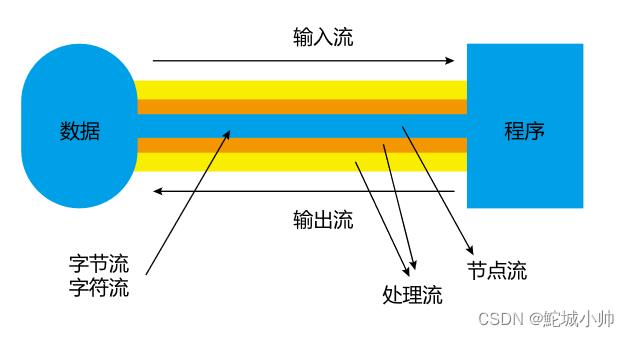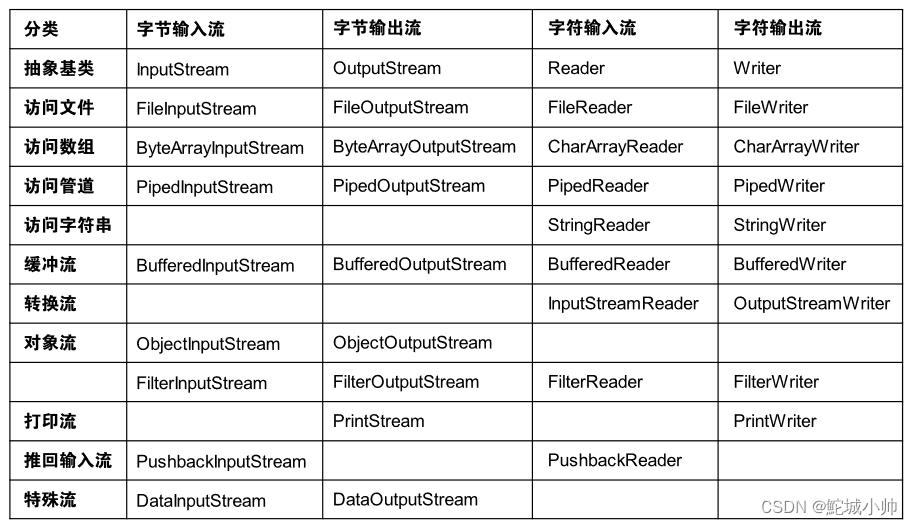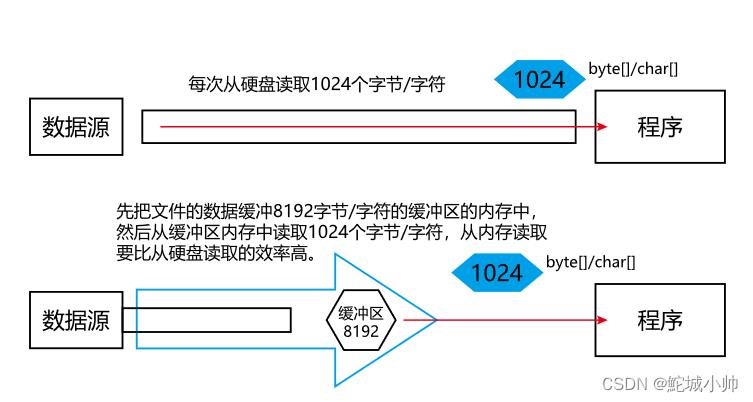Java - IO 流
Posted 鮀城小帅
tags:
篇首语:本文由小常识网(cha138.com)小编为大家整理,主要介绍了Java - IO 流相关的知识,希望对你有一定的参考价值。
1. File类的使用
1.1 File类
- java.io.File 类:文件和文件目录路径的抽象表示形式,与平台无关。
- File 能新建、删除、重命名文件和目录,但 File 不能访问文件内容本身。如果需要访问文件内容本身,则需要使用输入 / 输出流。
- 想要在 Java 程序中表示一个真实存在的文件或目录,那么必须有一个 File 对象,但是 Java 程序中的一个File 对象,可能没有一个真实存在的文件或目录。
- File 对象可以作为参数传递给流的构造器。
1.2 File类的使用
- File 类的一个对象,代表一个文件或一个文件目录( 俗称:文件夹 )。
- File 类声明在 java.io 包下。
- File 类中涉及到关于文件或文件目录的创建、删除、重命名、修改时间、文件大小等方法,并未涉及到写入或读取文件内容的操作。如果需要读取或写入文件内容必须使用 IO 流来完成。
- 后续 File 类的对象常会作为参数传递到流的构造器中,指明读取或写入的 " 终点 "。
1.3 File的实例化
(1)如何创建 file 类的实例
File(String filePath):以 filePath 为路径创建 File 对象,可以是绝对路径或者相对路径
File(String parentPath,String childPath): 以 parentPath 为父路径,childPath为子路径创建 File 对象。
File(File parentFile,String childPath):根据一个父 File 对象和子文件路径创建 File 对象
(2)相对路径:相较于某个路径下,指明的路径。
绝对路径:包含盘符在内的文件或文件目录的路径。
(3)路径分隔符
windows:\\\\
unix:/
(4)Java 程序支持跨平台运行,因此路径分隔符要慎用。
(5)为了解决这个隐患,File 类提供了一个常量:
public static final String separator。
//根据操作系统,动态的提供分隔符。
File file1= new File("d:\\\\Work\\\\info.txt");
File file2= new File("d:"+ File.separator+ "Work"+ File.separator+ "info.txt");
File file3= new File("d:/Wo1.4 File类的常用方法1
public String getAbsolutePath():获取绝对路径
public String getPath():获取路径
public String getName():获取名称
public String getParent():获取上层文件目录路径。若无,返回 null
public long length():获取文件长度(即:字节数)。不能获取目录的长度。
public long lastModified():获取最后一次的修改时间,毫秒值
如下的两个方法适用于文件目录:
public String[] list():获取指定目录下的所有文件或者文件目录的名称数组
public File[] listFiles():获取指定目录下的所有文件或者文件目录的 File 数组
public boolean renameTo(File dest): 把文件重命名为指定的文件案例:文件重命名
/**
* File 类的重命名功能
* public boolean renameTo(File dest): 把文件重命名为指定的文件
路径 比如:file1.renameTo(file2) 为例:
* 要想保证返回 true, 需要 file1 在硬盘中是存在的,且 file2 不能在
硬盘中存在。
*/
@Test
public void test1()
File file = new File("E:\\\\work_space\\\\iostream\\\\fileFolder\\\\hello.txt");
File file2 = new File("E:\\\\work_space\\\\IOStream\\\\fileFolder\\\\hello2.txt");
boolean renameTo = file.renameTo(file2);
System.out.println(renameTo);
1.5 File类的常用方法2
public boolean isDirectory():判断是否是文件目录
public boolean isFile():判断是否是文件
public boolean exists():判断是否存在
public boolean canRead():判断是否可读
public boolean canWrite():判断是否可写
public boolean isHidden():判断是否隐藏File初始化说明:
- 当硬盘中真有一个真实的文件或目录存在时,创建 File 对象时,各个属性会显式赋值。
- 当硬盘中没有真实的文件或目录对应时,那么创建对象时,除了指定的目录和路径之外,其他的属性都是取成员变量的默认值。
创建硬盘中对应的文件或文件目录;
public boolean createNewFile():创建文件。若文件存在,则不创建,返回 false;
public boolean mkdir():创建文件目录。如果此文件目录存在,就不创建了。
如果此文件目录的上层目录不存在,也不创建。
public boolean mkdirs():创建文件目录。如果上层文件目录不存在,一并创建。删除磁盘中的文件或文件目录
public boolean delete():删除文件或者文件夹。删除注意事项:Java 中的删除不走回收站。
案例:文件不存在就创建,文件存在才能删除
@Test
public void test2() throws IOException
File file = new File("E:\\\\work_space\\\\IOStream\\\\fileFolder\\\\hello.txt");
if(!file.exists())
// 文件不存在就创建
file.createNewFile();
System.out.println("创建成功");
else
// 文件存在,可进行删除
file.delete();
System.out.println("删除成功");
2. IO流原理与流的分类
2.1 IO流原理
I/O 是 Input/Output 的缩写,I/O 技术是非常实用的技术,用于处理设备之间的数据传输。如读 / 写文件,网络通讯等。
Java 程 序 中, 对 于 数 据 的 输 入 / 输 出 操 作 以“ 流(stream)”的方式进行。
java.io 包下提供了各种“流”类和接口,用以获取不同种类的数据,并通过标准的方法输入或输出数据。
输入 input:读取外部数据(磁盘、光盘等存储设备的数据)到程序(内存)中。
输出 output:将程序(内存)数据输出到磁盘、光盘等存储设备中。

2.2 流的分类
按操作数据单位不同分为:字节流 (8 bit),字符流 (16 bit)
按数据流的流向不同分为:输入流,输出流
按流的角色的不同分为:节点流,处理流
Java 的 IO 流共涉及 40 多个类,实际上非常规则,都是从如下 4 个抽象基类派生的。
由这四个类派生出来的子类名称都是以其父类名作为子类名后缀。
| 抽象基类 | 字节流 | 字符流 |
| 输入流 | InputStream | Reader |
| 输出流 | OutputStream | Writer |

2.3 IO流体系结构

2.3 节点流(或文件流)
2.3.1 FileReader读入数据的基本操作
| 抽象基类 | 节点流(或文件流) | 缓冲流(处理流的一种) |
| InputStream | FileInputStream (read(byte[] buffer)) | BufferedInputStream (read(byte[] buffer)) |
| OutputStream | FileOutputStream (write(byte[] buffer,0,len) | BufferedOutputStream (write(byte[] buffer,0,len) / flush() |
| Reader | FileReader (read(char[] cbuf)) | BufferedReader (read(char[] cbuf) / readLine()) |
| Writer | FileWriter (write(char[] cbuf,0,len) | BufferedWriter (write(char[] cbuf,0,len) / flush() |
读取文件【四个步骤】
建立一个流对象,将已存在的一个文件加载进流。
FileReaderfr= new FileReader(new File(“Test.txt”));
创建一个临时存放数据的数组。
char[] ch= new char[1024];
调用流对象的读取方法将流中的数据读入到数组中。
fr.read(ch);
关闭资源。
fr.close();
将 hello.txt 文件内容读入程序中,并输出到控制台
说明点:
1. read() 的理解:返回读入的一个字符。如果达到文件末尾,返回 -1。
2. 异常的处理:为了保证流资源一定可以执行关闭操作。需要使用try-catch-finally 处理。
3. 读入的文件一定要存在,否则就会报 FileNotFoundException。
案例:FileReader读入数据
@Test
public void test2()
FileReader fileReader = null;
try
// 实例化File对象,指明要操作的文件
File file = new File("E:\\\\work_space\\\\IOStream\\\\fileFolder\\\\hello2.txt");
// 提供具体的流
fileReader = new FileReader(file);
int data;
while ((fileReader.read()) != -1)
data = fileReader.read();
System.out.println((char)data);
catch (FileNotFoundException e)
e.printStackTrace();
catch (IOException e)
e.printStackTrace();
finally
try
if (fileReader != null)
fileReader.close();
catch (IOException e)
e.printStackTrace();
2.3.2 FileReader中使用 read(char[] cbuf) 读取数据
/**
* read(char[] cbuf):char[] 进行读取
*/
@Test
public void test3()
FileReader fileReader = null;
try
// 实例化File对象,指明要操作的文件
File file = new File("E:\\\\work_space\\\\IOStream\\\\fileFolder\\\\hello2.txt");
// 提供具体的流
fileReader = new FileReader(file);
char[] cbuf = new char[3];
int len;
while ((len = fileReader.read(cbuf)) != -1)
String str = new String(cbuf,0,len);
System.out.println(str);
catch (FileNotFoundException e)
e.printStackTrace();
catch (IOException e)
e.printStackTrace();
finally
if (fileReader != null)
try
fileReader.close();
catch (IOException e)
e.printStackTrace();
2.3.3 FileWriter写出数据的操作
写入文件
创建流对象,建立数据存放文件。
FileWriterfw= new FileWriter(new File(“Test.txt”));
调用流对象的写入方法,将数据写入流。
fw.write(“atguigu-songhongkang”);
关闭流资源,并将流中的数据清空到文件中。
fw.close();
说明:
(1) 输出操作,对应的 File 可以不存在的。并不会报异常。
(2)File 对应的硬盘中的文件如果不存在,在输出的过程中,会自动创建此文件。
File 对应的硬盘中的文件如果存在:
如果流使用的构造器是:FileWriter(file,false) / FileWriter(file): 对原有文件的覆盖。
如果流使用的构造器是:FileWriter(file,true): 不会对原有文件覆盖,而是在原有文件基础上追加内容。
案例:
/**
* fw.write(data):FileWriter 写出数据的操
*/
@Test
public void test4()
FileWriter fw = null;
try
// 实例化File对象,指明要写出到的文件
File file = new File("E:\\\\work_space\\\\IOStream\\\\fileFolder\\\\hello.txt");
// 提供FileWriter的对象,用于数据的写出
fw = new FileWriter(file);
// 写出的操作
fw.write("io stream -- FileWriter");
catch (FileNotFoundException e)
e.printStackTrace();
catch (IOException e)
e.printStackTrace();
finally
if (fw != null)
try
fw.close();
catch (IOException e)
e.printStackTrace();
2.3.4 使用 FileReader 和 FileWriter 实现文本文件的复制
/**
* 使用 FileReader 和 FileWriter 实现文本文件的复制
*/
@Test
public void test5()
FileWriter fw = null;
FileReader fr = null;
try
// 实例化File对象,指明要写出到的文件
File file = new File("E:\\\\work_space\\\\IOStream\\\\fileFolder\\\\hello2.txt");
File file2 = new File("E:\\\\work_space\\\\IOStream\\\\fileFolder\\\\hello3.txt");
// 创建输入流和输出流的对象
fr = new FileReader(file);
fw = new FileWriter(file2);
// 数据的读入和写出操作
char[] chars = new char[3];
int len;
while ((len = fr.read(chars)) != -1)
fw.write(chars,0,len);
catch (FileNotFoundException e)
e.printStackTrace();
catch (IOException e)
e.printStackTrace();
finally
if (fw != null)
try
fw.close();
catch (IOException e)
e.printStackTrace();
if (fr != null)
try
fr.close();
catch (IOException e)
e.printStackTrace();
2.3.5 不建议使用 FileInputStream 读取文本文件
原因:使用字节流 FileInputStream 处理文本文件,可能出现乱码。
测试 FileInputStream 和 FileOutputStream 的使用。
结论:
- 对于文本文件 (.txt,.java,.c,.cpp),使用字符流处理;
- 对于非文本文件 (.jpg,.mp3,.mp4,.avi,.doc,.ppt,...),使用字节流处理。
FileInputStream fi = null;
try
// 实例化File对象,指明要写出到的文件
File file = new File("E:\\\\work_space\\\\IOStream\\\\fileFolder\\\\hello3.txt");
// 创建输入流和输出流的对象
fi = new FileInputStream(file);
// 数据的读入和写出操作
byte[] bytes = new byte[1024];
int len;
while ((len = fi.read(bytes)) != -1)
String str = new String(bytes,0,len);
System.out.println(str);
catch (FileNotFoundException e)
e.printStackTrace();
catch (IOException e)
e.printStackTrace();
finally
if (fi != null)
try
fi.close();
catch (IOException e)
e.printStackTrace();
2.3.6 使用 FileInputStream 和 FileOutputStream 读写非文本文件
实现对图片的复制操作
/**
* 使用 FileReader 和 FileWriter 实现文本文件的复制
*/
@Test
public void test7()
FileInputStream fi = null;
FileOutputStream fo = null;
try
// 实例化File对象,指明要写出到的文件
File file = new File("E:\\\\work_space\\\\IOStream\\\\fileFolder\\\\hzw.webp");
File file2 = new File("E:\\\\work_space\\\\IOStream\\\\fileFolder\\\\hzw2.webp");
// 创建输入流和输出流的对象
fi = new FileInputStream(file);
fo = new FileOutputStream(file2);
// 数据的读入和写出操作
byte[] buffer = new byte[1024];
int len;
while ((len = fi.read(buffer)) != -1)
fo.write(buffer,0,len);
catch (FileNotFoundException e)
e.printStackTrace();
catch (IOException e)
e.printStackTrace();
finally
if (fi != null)
try
fi.close();
catch (IOException e)
e.printStackTrace();
if (fo != null)
try
fo.close();
catch (IOException e)
e.printStackTrace();
2.4 缓冲流
为了提高数据读写的速度,Java API 提供了带缓冲功能的流类,在使用这些流类时,会创建一个内部缓冲区数组,缺省使用 8192 个字节 (8Kb) 的缓冲区。

缓冲流要“套接”在相应的节点流之上,根据数据操作单位可以把缓冲流分为:
BufferedInputStream 和 BufferedOutputStream;
BufferedReader 和 BufferedWriter;
当读取数据时,数据按块读入缓冲区,其后的读操作则直接访问缓冲区。
当使用 BufferedInputStream 读取字节文件时,BufferedInputStream 会一次性从文件中读取 8192 个 (8Kb),存在缓冲区中,直到缓冲区装满了,才重新从文件中读取下一个 8192 个字节数组。
向流中写入字节时,不会直接写到文件,先写到缓冲区中直到缓冲区写满,BufferedOutputStream 才会把缓冲区中的数据一次性写到文件里。使用方法 flush() 可以强制将缓冲区的内容全部写入输出流。
关闭流的顺序和打开流的顺序相反。只要关闭最外层流即可,关闭最外层流也会相应关闭内层节点流。
flush() 方法的使用:手动将 buffer 中内容写入文件。
如果是带缓冲区的流对象的 close() 方法,不但会关闭流,还会在关闭流之前刷新缓冲区,关闭后不能再写出。

2.4.1 缓冲流(字节型)实现非文本文件的复制
处理流之一:缓冲流的使用
(1)缓冲流:
BufferedInputStream
BufferedOutputStream
BufferedReader
BufferedWriter
(2)作用:提供流的读取、写入的速度;
提高读写速度的原因:内部提供了一个缓冲区。
(3)处理流,就是“套接”在已有的流的基础上。
案例:基于缓冲流实现读写
@Test
public void test1()
BufferedInputStream bis = null;
BufferedOutputStream bos = null;
try
// 实例化File对象,指明要写出到的文件
File file = new File("E:\\\\work_space\\\\IOStream\\\\fileFolder\\\\hzw2.webp");
File file2 = new File("E:\\\\work_space\\\\IOStream\\\\fileFolder\\\\hzw3.webp");
// 创建输入流和输出流的对象
FileInputStream fi = new FileInputStream(file);
FileOutputStream fo = new FileOutputStream(file2);
// 创建缓冲流
bis = new BufferedInputStream(fi);
bos = new BufferedOutputStream(fo);
// 数据的读入和写出操作
byte[] buffer = new byte[1024];
int len;
while ((len = bis.read(buffer)) != -1)
bos.write(buffer,0,len);
catch (FileNotFoundException e)
e.printStackTrace();
catch (IOException e)
e.printStackTrace();
finally
// 要求:先关闭外层的流,再关闭内层的流
if (bos != null)
try
bos.close();
catch (IOException e)
e.printStackTrace();
if (bis != null)
try
bis.close();
catch (IOException e)
e.printStackTrace();
// 说明:关闭外层流的同时,内层流也会自动的进行关闭。
// 关于内层流的关闭,我们可以省略 .
缓冲流与节点流读写速度说明:基于缓冲流的读写速度要比节点流快很多。
2.4.2 缓冲流(字符型)实现文本文件的复制
// 使用 BufferedReader 和 BufferedWriter 实现文本文件的复制
@Test
public void test1()
BufferedReader br = null;
BufferedWriter bw = null;
try
// 实例化File对象,指明要写出到的文件
File file = new File("E:\\\\work_space\\\\IOStream\\\\fileFolder\\\\hello2.txt");
File file2 = new File("E:\\\\work_space\\\\IOStream\\\\fileFolder\\\\hello4.txt");
// 创建输入流和输出流的对象
br = new BufferedReader(new FileReader(file));
bw = new BufferedWriter(new FileWriter(file2));
// 读写操作
// 方式一:使用 char[] 数组
// char[] cbuf = new char[1024];
// int len;
// while ((len = br.read(cbuf)) != -1)
// bw.write(cbuf, 0, len);
// bw.flush();
// 方式二:使用String
// 数据的读入和写出操作
String data;
while ((data = br.readLine()) != null)
// 方法一:
// bw.write(data + "\\n");//data 中不包含换行符
// 方法二:
bw.write(data); // data 中不包含换行符
bw.newLine(); // 提供换行的操作
catch (FileNotFoundException e)
e.printStackTrace();
catch (IOException e)
e.printStackTrace();
finally
// 要求:先关闭外层的流,再关闭内层的流
if (br != null)
try
br.close();
catch (IOException e)
e.printStackTrace();
if (bw != null)
try
bw.close();
catch (IOException e)
e.printStackTrace();
// 说明:关闭外层流的同时,内层流也会自动的进行关闭。
// 关于内层流的关闭,我们可以省略 .
2.5 转换流
2.5.1 转换流概述与 InputStreamReader 的使用。
转换流提供了在字节流和字符流之间的转换。
Java API 提供了两个转换流:
(1) InputStreamReader:将 InputStream 转换为 Reader
实现将字节的输入流按指定字符集转换为字符的输入流。
需要和 InputStream“套接”。
构造器:
public InputStreamReader(InputStreamin)
public InputSreamReader(InputStreamin,StringcharsetName)
如:Reader isr= new InputStreamReader(System.in,”gbk”);
(2)OutputStreamWriter:将 Writer 转换为 OutputStream
实现将字符的输出流按指定字符集转换为字节的输出流。
需要和 OutputStream“套接”。
构造器:
public OutputStreamWriter(OutputStreamout)
public OutputSreamWriter(OutputStreamout,StringcharsetName)
字节流中的数据都是字符时,转成字符流操作更高效。
很多时候我们使用转换流来处理文件乱码问题,实现编码和解码的功能。

2.5.2 转换流的使用
(1)转换流:属于字符流;
InputStreamReader:将一个字节的输入流转换为字符的输入流。
OutputStreamWriter:将一个字符的输出流转换为字节的输出流。
(2)作用:提供字节流与字符流之间的转换。
(3)解码:字节、字节数组 ---> 字符数组、字符串。
编码:字符数组、字符串 ---> 字节、字节数组。
(4)字符集
ASCII:美国标准信息交换码。用一个字节的 7 位可以表示。
ISO8859-1:拉丁码表。欧洲码表。用一个字节的 8 位表示。
GB2312:中国的中文编码表。最多两个字节编码所有字符。
GBK:中国的中文编码表升级,融合了更多的中文文字符号。最多两个字节编码。
Unicode:国际标准码,融合了目前人类使用的所有字符。为每个字符
分配唯一的字符码。所有的文字都用两个字节来表示。
UTF-8:变长的编码方式,可用 1-4 个字节来表示一个字符。
Unicode 不完美,这里就有三个问题,一个是,我们已经知道,英文字母只用一个字节表示就够了,第二个问题是如何才能区别 Unicode 和ASCII ?计算机怎么知道两个字节表示一个符号,而不是分别表示两个符号呢?第三个,如果和 GBK 等双字节编码方式一样,用最高位是 1 或 0 表示两个字节和一个字节,就少了很多值无法用于表示字符,不够表示所有字符。
Unicode 在很长一段时间内无法推广,直到互联网的出现。
面向传输的众多 UTF(UCS Transfer Format)标准出现了,顾名思义,UTF-8 就是每次 8 个位传输数据,而 UTF-16 就是每次 16 个位。 这是为传输而设计的编码,并使编码无国界,这样就可以显示全世界上所有文化的字符了。
Unicode 只是定义了一个庞大的、全球通用的字符集,并为每个字符规定了唯一确定的编号,具体存储成什么样的字节流,取决于字符编码方案。
推荐的 Unicode 编码是 UTF-8 和 UTF-16。
/**
* 此时处理异常的话,仍然应该使用 try-catch-finally InputStreamReader
* 的使用,实现字节的输入流到字符的输入流的转换
* @throws FileNotFoundException
*/
@Test
public void test1() throws FileNotFoundException
FileInputStream fis = null;
InputStreamReader isr = null;
try
fis = new FileInputStream("E:\\\\work_space\\\\IOStream\\\\fileFolder\\\\hello3.txt");
// 使用系统默认的字符集
// 参数 2 指明了字符集,具体使用哪个字符集,取决于文件 hello3.txt 保存时使用的字符集
isr = new InputStreamReader(fis,"UTF-8");
char[] chars = new char[5];
int len;
while ((len = isr.read(chars)) != -1)
String str = new String(chars,0,len);
System.out.println(str);
catch (UnsupportedEncodingException e)
e.printStackTrace();
catch (IOException e)
e.printStackTrace();
finally
if (isr != null)
try
isr.close();
catch (IOException e)
e.printStackTrace();
2.6 标准输入、输出流、打印流、数据流
2.6.1 标准输入、输出流
System.in 和 System.out 分别代表了系统标准的输入和输出设备;
默认输入设备是:键盘,输出设备是:显示器;
System.in 的类型是 InputStream;
System.out 的 类 型 是 PrintStream, 其 是 OutputStream的子类 FilterOutputStream 的子类;
重定向:通过 System 类的 setIn,setOut 方法对默认设备进行改变。
public static void setIn(InputStreamin)
public static void setOut(PrintStreamout)2.6.2 其他流的使用
- 标准的输入、输出流
- 打印流
- 数据流
(1)标准的输入、输出流
System.in: 标准的输入流,默认从键盘输入;
System.out: 标准的输出流,默认从控制台输出
System 类的 setIn(InputStream is) / setOut(PrintStream ps) 方式重新指定输入和输出的流。
@Test
public void test2() throws FileNotFoundException
BufferedReader br = null;
try
InputStreamReader isr = new InputStreamReader(System.in);
br = new BufferedReader(isr);
while (true)
System.out.println("请输入字符串:");
String data = br.readLine();
if ("e".equalsIgnoreCase(data) || "exit".equalsIgnoreCase(data))
System.out.println("程序结束");
break;
String upperCase = data.toUpperCase();
System.out.println(upperCase);
catch (IOException e)
e.printStackTrace();
finally
if (br != null)
try
br.close();
catch (IOException e)
e.printStackTrace();
2.6.3 打印流、数据流
打印流:实现将基本数据类型的数据格式转化为字符串输出;
打印流:PrintStream 和 PrintWriter;
- 提供了一系列重载的 print() 和 println() 方法,用于多种数据类型的输出。
- PrintStream 和 PrintWriter 的 输 出 不 会 抛 出IOException 异常。
- PrintStream 和 PrintWriter 有自动 flush 功能
- PrintStream 打印的所有字符都使用平台的默认
字符编码转换为字节。在需要写入字符而不是写入字节的情况下,应该使用 PrintWriter 类。
- System.out 返回的是 PrintStream 的实例。
数据流:为了方便地操作 Java 语言的基本数据类型和 String 的数据,可以使用数据流。
数据流有两个类:( 用于读取和写出基本数据类型、String 类的数据)
- DataInputStream 和 DataOutputStream
- 分 别“ 套 接” 在 InputStream 和 OutputStream子类的流上。
DataInputStream 中的方法:
- boolean readBoolean()
- byte readByte()
- char readChar()
- float readFloat()
- double readDouble()
- short readShort()
- long readLong()
- int readInt()
- String readUTF()
- void readFully(byte[s] b
将上述的方法的 read 改为相应的 write 即可。
(1)打印流:PrintStream 和 PrintWriter。提供了一系列重载的 print() 和 println()
(2)数据流:
- DataInputStream 和 DataOutputStream
- 作用:用于读取或写出基本数据类型的变量或字符串。
案例:
(1)打印流
@Test
public void test()
PrintStream ps = null;
try
FileOutputStream fos = new FileOutputStream(new File("E:\\\\work_space\\\\IOStream\\\\fileFolder\\\\hello3.txt"));
// 创建打印输出流,设置为自动刷新模式(写入换行符或字节‘\\n’时都会刷新输出缓冲区
ps = new PrintStream(fos,true);
if (ps != null)
System.out.println(ps);
for (int i = 0; i <= 255; i++)
System.out.println((char)i);
if (i % 50 == 0)
System.out.println();
catch (FileNotFoundException e)
e.printStackTrace();
finally
if (ps != null)
ps.close();
(2)DataInputStream和DataOutputStream
@Test
public void test2()
DataOutputStream dos = null;
try
dos = new DataOutputStream(new FileOutputStream("E:\\\\work_space\\\\IOStream\\\\fileFolder\\\\hello3.txt"));
dos.writeUTF("商大");
dos.flush();// 刷新操作,将内存中的数据写入文件
dos.writeInt(23);
dos.writeBoolean(true);
dos.flush();
catch (FileNotFoundException e)
e.printStackTrace();
catch (IOException e)
e.printStackTrace();
finally
if (dos != null)
try
dos.close();
catch (IOException e)
e.printStackTrace();
/**
* // 将文件中存储的基本数据类型变量和字符串读取到内存中,保存在
* 变量中。
* // 注意点:读取不同类型的数据的顺序要与当初写入文件时,保存的
* 数据的顺序一致!
*/
@Test
public void test3()
DataInputStream dis = null;
try
dis = new DataInputStream(new FileInputStream("E:\\\\work_space\\\\IOStream\\\\fileFolder\\\\hello3.txt"));
String name = dis.readUTF();
int age = dis.readInt();
boolean isMale = dis.readBoolean();
System.out.println("name = " + name);
System.out.println("age = " + age);
System.out.println("isMale = " + isMale);
dis.close();
catch (FileNotFoundException e)
e.printStackTrace();
catch (IOException e)
e.printStackTrace();
2.7 对象流
2.7.1 对象序列化机制的理解
ObjectInputStream 和 OjbectOutputSteam。用于存储和读取基本数据类型数据或对象的处理流。它的强大之处就是可以把 Java 中的对象写入到数据源中,也能把对象从数据源中还原回来。
序列化:用 ObjectOutputStream 类保存基本类型数据或对象的机制。
反序列化:用 ObjectInputStream 类读取基本类型数据或对象的机制。
ObjectOutputStream 和 ObjectInputStream 不能序列化 static 和 transient修饰的成员变量。
对象序列化机制允许把内存中的 Java 对象转换成平台无关的二进制流,从而允许把这种二进制流持久地保存在磁盘上,或通过网络将这种二进制流传输到另一个网络节点。当其它程序获取了这种二进制流,就可以恢复成原来的 Java 对象。
序列化的好处在于可将任何实现了 Serializable 接口的对象转化为字节数据,使其在保存和传输时可被还原。
序列化是 RMI(Remote Method Invoke - 远程方法调用)过程的参数和返回值都必须实现的机制,而 RMI 是 JavaEE 的基础。因此序列化机制是 JavaEE 平台的基础。
如果需要让某个对象支持序列化机制,则必须让对象所属的类及其属性是可序列化的,为了让某个类是可序列化的,该类必须实现如下两个接口之一。否则,会抛出 NotSerializableException 异常。
- Serializable
- Externalizable
2.7.2 对象流序列化与反序列化字符串
对象流的使用:
- ObjectInputStream 和 ObjectOutputStream
- 作用:用于存储和读取基本数据类型数据或对象的处理流。它的强大之处就是可以把 Java 中的对象写入到数据源中,也能把对象从数据源中还原回来。
/**
* 序列化过程:将内存中的 java 对象保存到磁盘中或通过网络传输出去
* 使用 ObjectOutputStream 实现
*/
@Test
public void test1()
ObjectOutputStream oos = null;
try
// 创建流
oos = new ObjectOutputStream(new FileOutputStream("object.dat"));
// 创建对象
oos.writeObject(new String("五菱宏光"));
// 刷新
oos.flush();
catch (FileNotFoundException e)
e.printStackTrace();
catch (IOException e)
e.printStackTrace();
finally
if (oos != null)
try
oos.close();
catch (IOException e)
e.printStackTrace();
/**
* 反序列化:将磁盘文件中的对象还原为内存中的一个 java 对象
* 使用 ObjectInputStream 来实现
*/
@Test
public void test2()
ObjectInputStream ois = null;
try
ois = new ObjectInputStream(new FileInputStream("object.dat"));
Object obj = ois.readObject();
String str = (String)obj;
System.out.println(str);
catch (FileNotFoundException e)
e.printStackTrace();
catch (IOException e)
e.printStackTrace();
catch (ClassNotFoundException e)
e.printStackTrace();
finally
if (ois != null)
try
ois.close();
catch (IOException e)
e.printStackTrace();
2.7.3 自定义类实现序列化与反序列化操作
若某个类实现了 Serializable 接口,该类的对象就是可序列化的:
- 创建一个 ObjectOutputStream。
- 调用 ObjectOutputStream 对象的 writeObject( 对象 )方法输出可序列化对象。
- 注意写出一次,操作 flush() 一次。
反序列化
- 创建一个 ObjectInputStream 对象调用 readObject()方法读取流中的对象。
强调:如果某个类的属性不是基本数据类型或 String类型,而是另一个引用类型,那么这个引用类型必须是可序列化的,否则拥有该类型的 Field 的类也不能序列化。
对象流的使用:
(1)ObjectInputStream 和 ObjectOutputStream。
(2)作用:用于存储和读取基本数据类型数据或对象的处理流。它的强大之处就是可以把 Java 中的对象写入到数据源中,也能把对象从数据源中还原回来。
(3)要想一个 java 对象是可序列化的,需要满足相应的要求。见 Person.java。
(4)序列化机制:
对象序列化机制允许把内存中的 Java 对象转换成平台无关的二进制流,从而允许把这种。
二进制流持久地保存在磁盘上,或通过网络将这种二进制流传输到另一个网络节点。
当其它程序获取了这种二进制流,就可以恢复成原来的 Java 对象。
案例
/**
* @author wushaopei
* @create 2022-07-07 21:58
*/
public class Person implements Serializable
public static final long serialVersionUID = 475463534532L;
private String name;
private int age;
public Person()
public Person(String name, int age)
this.name = name;
this.age = age;
@Override
public String toString()
return "Person" + "name='" + name + '\\'' + ", age=" +
age + '';
public String getName()
return name;
public void setName(String name)
this.name = name;
public int getAge()
return age;
public void setAge(int age)
this.age = age;
序列化与反序列化
package com.io.file;
import com.io.file.entity.Person;
import org.junit.Test;
import java.io.*;
/**
* @author wushaopei
* @create 2022-07-07 21:59
*/
public class ObjectTest
@Test
public void serial()
ObjectOutputStream oos = null;
try
// 创建流
oos = new ObjectOutputStream(new FileOutputStream("object.dat"));
// 创建对象
oos.writeObject(new String("创建新对象"));
// 刷新
oos.flush();
// 继续写
oos.writeObject(new Person("java",44));
oos.flush();
catch (IOException e)
e.printStackTrace();
finally
if (oos != null)
try
oos.close();
catch (IOException e)
e.printStackTrace();
@Test
public void deserial()
ObjectInputStream ois = null;
try
// 创建流
ois = new ObjectInputStream(new FileInputStream("object.dat"));
Object o = ois.readObject();
String s = (String)o;
Person p = (Person) ois.readObject();
System.out.println(s);
System.out.println(p);
catch (IOException e)
e.printStackTrace();
catch (ClassNotFoundException e)
e.printStackTrace();
finally
if (ois != null)
try
ois.close();
catch (IOException e)
e.printStackTrace();
2.7.4 serialVersionUID 的理解
凡是实现 Serializable 接口的类都有一个表示序列化版本标识符的静态变量:
- private static final long serialVersionUID;
- serialVersionUID 用来表明类的不同版本间的兼容性。简言之,其目的是以序列化对象进行版本控制,有关各版本反序列化时是否兼容。
- 如果类没有显示定义这个静态常量,它的值是Java 运行时环境根据类的内部细节自动生成的。若类的实例变量做了修改,serialVersionUID 可能发生变化。故建议,显式声明。
简单来说,Java 的序列化机制是通过在运行时判断类的 serialVersionUID 来验证版本一致性的。在进行反序列化时,JVM 会把传来的字节流中的 serialVersionUID 与本地相应实体类的 serialVersionUID 进行比较,如果相同就认为是一致的,可以进行反序列化,否则就会出现序列
化版本不一致的异常。(InvalidCastException)
Person 需要满足如下的要求,方可序列化:
- 需要实现接口:Serializable;
- 当前类提供一个全局常量:serialVersionUID;
- 除了当前 Person 类需要实现 Serializable 接口之外,还必须保证其内部所有属性。
也必须是可序列化的。(默认情况下,基本数据类型可序列化)
public static final long serialVersionUID = 475463534532L;2.7.5 随机存取文件流
RandomAccessFile 声明在 java.io 包下,但直接继承于 java.lang.Object 类。 并 且 它 实 现 了 DataInput、DataOutput 这两个接口,也就意味着这个类既可以读也可以写。
RandomAccessFile 类支持“随机访问” 的方式,程序可以直接跳到文件的任意地方来读、写文件:
·支持只访问文件的部分内容·可以向已存在的文件后追加内容RandomAccessFile 对象包含一个记录指针,用以标示当前读写处的位置。RandomAccessFile 类对象可以自由移动记录指针:
- long getFilePointer():获取文件记录指针的当前位置。
- void seek(long pos):将文件记录指针定位到 pos 位置。
构造器:
- public RandomAccessFile(Filefile, Stringmode)
- public RandomAccessFile(Stringname, Stringmode)
创建 RandomAccessFile 类实例需要指定一个 mode 参数,
该参数指定 RandomAccessFile 的访问模式:
- r : 以只读方式打开
- rw:打开以便读取和写入
- rwd: 打开以便读取和写入;同步文件内容的更新
- rws: 打开以便读取和写入;同步文件内容和元数据
的更新。
如果模式为只读 r。则不会创建文件,而是会去读取一个
已经存在的文件,如果读取的文件不存在则会出现异常。
如果模式为 rw 读写。如果文件不存在则会去创建文件,
如果存在则不会创建。
2.8.1 RandomAccessFile 实现数据的读写操作
RandomAccessFile 的使用:
- RandomAccessFile 直 接 继 承 于 java.lang.Object 类, 实 现 了 DataInput和 DataOutput 接口。
- RandomAccessFile 既可以作为一个输入流,又可以作为一个输出流。
- 如果 RandomAccessFile 作为输出流时,写出到的文件如果不存在,则在执行过程中自动创建。如果写出到的文件存在,则会对原有文件内容进行覆盖。(默认情况下,从头覆盖)
- 可以通过相关的操作,实现 RandomAccessFile“插入”数据的效果。
案例:
demo1--读取图片
RandomAccessFile raf1 = null;
RandomAccessFile raf2 = null;
try
raf1 = new RandomAccessFile(new File("xx.jpg"), "r");
raf2 = new RandomAccessFile(new File("xx.jpg"), "rw");
byte[] buffer = new byte[1024];
int len;
while ((len = raf1.read(buffer)) != -1)
raf2.write(buffer, 0, len);
catch (IOException e)
e.printStackTrace();
finally
if (raf1 != null)
try
raf1.close();
catch (IOException e)
e.printStackTrace();
if (raf2 != null)
try
raf2.close();
catch (IOException e)
e.printStackTrace();
demo2-读取txt文件
RandomAccessFile raf1 = new RandomAccessFile("hello.txt", "rw");
raf1.write("xyz".getBytes());
raf1.close();demo3-插入数据
@Test
public void test3() throws IOException
RandomAccessFile raf1 = new RandomAccessFile("hello.txt", "rw");
raf1.seek(3); // 将指针调到角标为 3 的位置
// 保存指针 3 后面的所有数据到 StringBuilder 中
StringBuilder builder = new StringBuilder((int) new File("hello.txt").length());
byte[] buffer = new byte[20];
int len;
while ((len = raf1.read(buffer)) != -1)
builder.append(new String(buffer, 0, len));
// 调回指针,写入“xyz”
raf1.seek(3);
raf1.write("xyz".getBytes());
// 将 StringBuilder 中的数据写入到文件中
raf1.write(builder.toString().getBytes());
raf1.close();
// 思考:将 StringBuilder 替换为 ByteArrayOutputStream
2.9.1 NIO.2中Path、Paths、Files类的使用
Java NIO (New IO,Non-Blocking IO) 是 从 Java 1.4版本开始引入的一套新的 IO API,可以替代标准的 JavaIO API。NIO 与原来的 IO 有同样的作用和目的,但是使用的方式完全不同,NIO 支持面向缓冲区的 (IO 是面向流的 )、基于通道的 IO 操作。NIO 将以更加高效的方式进行文件的读写操作。
Java API 中提供了两套 NIO,一套是针对标准输入输出 NIO,另一套就是网络编程 NIO。

随着 JDK 7 的发布,Java 对 NIO 进行了极大的扩展,增强了对文件处理和文件系统特性的支持,以至于我们称他们为 NIO.2。因为 NIO 提供的一些功能,NIO 已经成为文件处理中越来越重要的部分。
早期的 Java 只提供了一个 File 类来访问文件系统,但File 类的功能比较有限,所提供的方法性能也不高。而且,大多数方法在出错时仅返回失败,并不会提供异常信息。
NIO. 2 为了弥补这种不足,引入了 Path 接口,代表一个平台无关的平台路径,描述了目录结构中文件的位置。Path 可以看成是 File 类的升级版本,实际引用的资源也可以不存在。
(1)Path接口
- String toString():返回调用 Path 对象的字符串表示形式;
- boolean startsWith(String path): 判断是否以 path 路径开始;
- boolean endsWith(String path):判断是否以 path 路径结束;
- boolean isAbsolute():判断是否是绝对路径;
- Path getParent():返回 Path 对象包含整个路径,不包含 Path 对象指定的文件路径;
- Path getRoot():返回调用 Path 对象的根路径;
- Path getFileName():返回与调用 Path 对象关联的文件名;
- intgetNameCount():返回 Path 根目录后面元素的数量;
- Path getName(int idx):返回指定索引位置 idx 的路径名称;
- Path toAbsolutePath():作为绝对路径返回调用 Path 对象;
- Path resolve(Path p):合并两个路径, 返回台并后的路径对应的 Path 对象;
- File toFile():将 Path 转化为 File 类的对象。
(2)Files类
Files 常用方法:用于判断
Files 常用方法:用于判断
- boolean exist(Path path, LinkOption .. opts):判断文件是否存在
- boolean isDirectory(Path path, LinkOption .. opts):判断是否是目录
- boolean isRegularFile(Path path, LinkOption .. opts):判断是否是文件
- boolean isHidden(Path path):判断是否是隐藏文件
- boolean isReadable(Path path):判断文件是否可读
- boolean isWritable(Path path):判断文件是否可写
- boolean notExists(Path path, LinkOption .. opts):判断文件是否不存在
Files 常用方法 : 用于操作内容
- SeekableByteChannel newByteChannel(Path path, OpenOption..how):获取与指定文件的连接,how 指定打开方式。
- DirectoryStream<Path> newDirectoryStream(Path path):打开 path 指定的目录。
- InputStream newlnputStream(Path path, OpenOption..how):获取InputStream 对象。
- OutputStream newOutputStream(Path path, OpenOptin...how):获取OutputStream 对象。
javano.file.Files 用于操作文件或目录的工具类。
Files 常用方法:
- Path copy(Path src, Path dest, CopyOption ... how):文件的复制;
- Path createDirectory(Path path, FileAttribute<?> .... attr):创建一个目录;
- Path createFile(Path path, FileAttribute<?> ... arr):创建一一个文件;
- void delete(Path path):删除一个文件 / 目录,如果不存在,执行报错;
- void deletelfExists(Path path):Path 对应的文件 / 月录如果存在,执行删除;
- Path move(Path sre, Path dest, CopyOption.. .how):将 src 移动到 dest 位置;
- long size(Path path):返回 path 指定文件的大小。
以上是关于Java - IO 流的主要内容,如果未能解决你的问题,请参考以下文章